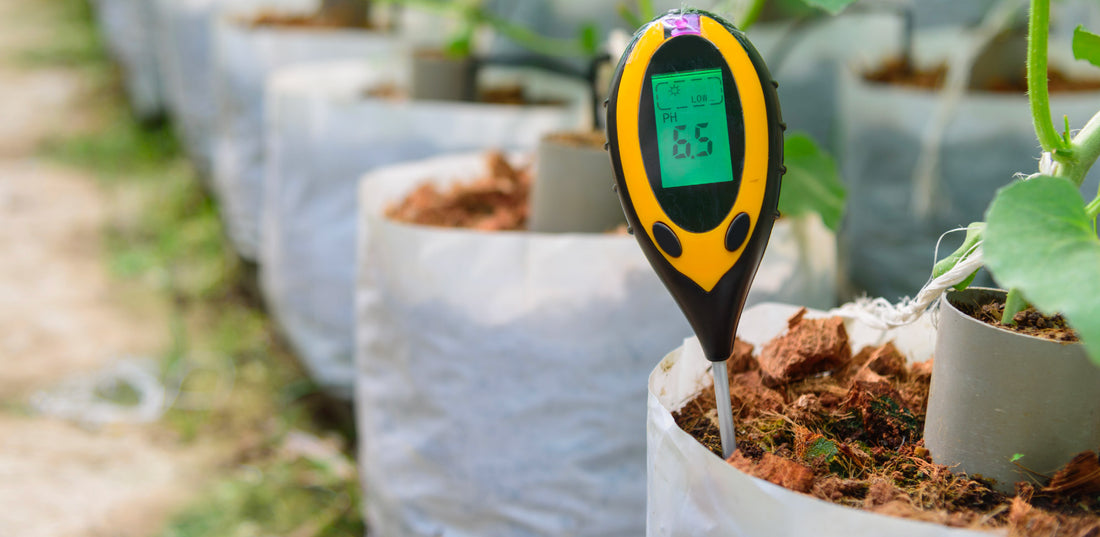
Congratulations! We are so glad you've stumbled upon this article because it means you're one of us - a full-blown plant nerd! But did you know that the pH of your soil and hydroponic solution can make all the difference when it comes to the health and success of your plants? Even if you've got the perfect amount of light, moisture, and nutrients, if your plant's pH is off, it might starving and struggling. So, let's get into the nitty-gritty of soil pH and give your plants the love and care they deserve!
Plant pH is the secret to plant health that no one is talking about. It sounds complicated, but don't worry, it's easy to figure out!
Feeling like your brain might explode from information overload? Fear not! You've already made some serious headway, so pat yourself on the back. And hey, when it comes to monitoring pH levels, it's a total no-brainer.
So don't sweat it, you'll be a pH pro in a jiffy!
Plant pH Basics
What is meant by pH
pH is the measure of the acidity or alkalinity of water or the media our plants are growing in. The pH scale ranges from 0 to 14 and a value of 7 is considered as neutral. If the pH is less than 7, it is acidic and if it exceeds 7, it is alkaline.

Optimal pH in Soil vs Soilless Media
There is an optimal pH for all plants to keep them healthy. Do you know that the optimal pH for a particular plant is different in soil compared to when grown in a soilless medium? This is pretty shocking, but there is a good explanation for this. Nutrients in a soilless medium become more available around pH 5 to 6 (more acidic), while in the soil they are more available at pH 6.0 to 7.0 (more neutral).
Nutrients in a hydroponic or semi-hydroponic setting become more available at lower pH levels. Every plant has different requirements.
For example, for Ficus species in LECA, a range of 5 to 6 is preferred, while in the soil, it thrives at a higher level between 6.5 and 7. The same goes for other household plants such as Monsteras, Philodendrons, Sansevieria, and Anthurium.
Impact of pH on plant growth
The pH of your plant's growing medium can totally affect how mobile its nutrients are, and that, in turn, can determine how available they are to your precious plant. But beware, letting the pH go way out of whack can lead to some serious consequences. If your plant can't absorb all the nutrients it needs, it might end up suffering from nutrient deficiencies, and that's no good for plant health. To make matters worse, it can also lead to heavy metal toxicity, which is definitely not what we want for our green friends. Keep that pH in check, folks!
Out of whack pH levels make it impossible for your plant to use nutrients.

Sciencey stuff: If you don't check, your plant might start feeling some serious nutrient FOMO at higher pH levels (we're talking above 7.5). At this point, phosphorus, magnesium, and calcium can become almost as rare as a unicorn. To make matters worse, phosphorus can start reacting with magnesium and calcium to form compounds that are basically off-limits to your plant. On the flip side, at lower, more acidic pH values, phosphate tends to cozy up to aluminum and iron, making those essential nutrients less accessible. If the pH drops too low (below 4.0), you might even see some micronutrient toxicities creeping in - think manganese, aluminum, and iron at toxic levels. Yikes!
Soil microbes help maintain healthier pH levels. This is why feeding the soil microbiome is so important. Read about it here.
You must remember that in soilless conditions, there are no microbes and organic matter to help regulate and maintain the pH of the media. So, when growing plants in LECA and soilless media, it's important to keep an eye on the pH to ensure it's not way out of range. If you find the pH out of balance, it is best to remove all liquid, flush it with water, and replace the nutrient mixture.
How to check pH
There are different tools you will need to check pH of a fertilizer solution vs the pH of your plant soil. Both tools are common and relatively inexpensive. They will become very useful for you as you mature into an adulting plant parent.
Checking pH of water and fertilizer solution
This step is important to ensure you have the correct pH especially for hydroponic and semi-hydroponic settings. It can be easily done by pouring a few milliliters of the solution into a small container such as a measuring cup. The simplest way is to use a digital pH pen (as seen in the picture). You simply dip the electrode in the fertilizer solution. The reading is displayed digitally on the screen.
You can browse hydroponic pH testers at this link: Hydroponic pH tester
Check out the image below, which displays the pH readings of fertilizer mixed into both distilled water (on the left) and California's finest tap water (on the right). As you can see, the pH of fertilizer mixed with distilled water is approximately 5, while the pH of fertilizer mixed with tap water is about 6.2.

A slightly cheaper option will be to use a pH Test Indicator. It may not be as accurate as the digital pH pen, but it can still give you an acceptable pH reading. All you have to do is to add a few drops of the test Indicator solution to the fertilizer solution. There will be a color change in the fertilizer solution. To get the pH reading, you must compare the color with the chart provided.
Checking pH in soil
Digital pH meters are a valuable tool to have. To use a pH meter, insert the probe into the soil to a depth of about 4 inches and wait for the reading to stabilize. Be sure to follow the manufacturer's instructions carefully to get an accurate reading. The one featured below is a handy tool that also acts as a hygrometer for checking soil moisture.

Tap Water vs Distilled Water
So, the main difference between using tap water and distilled water in your fertilizer solution is basically the mineral content and purity of the water.
Tap water can be kind of unpredictable when it comes to minerals. Depending on where you live, your tap water might have varying levels of calcium, magnesium, sodium, chlorine, and other chemicals that are added during the water treatment process. Typical fertilizers will have a chemical reaction in tap water and cause them to be less available to plants. The awesome news is that Bless Your Soil® contains organically bonded minerals that won't have this negative impact. Our fertilizers are the chemically stable to handle differences in water hardness and pH—so using tap water for houseplants, gardens, and lawns with Bless Your Soil® is totally fine.
On the other hand, distilled water is like the purified prince charming of water. It's been boiled and condensed to remove most (if not all) of the minerals and impurities present in the original water source. Distilled water becomes more useful in soilless and hydroponic situations because it will usually render a slightly more acidic solution that plants need. (Bless Your Soil® fertilizers render to approximately level 5 when mixed with distilled water).
Adjusting the pH
To ensure the nutrient solution's pH is in the range you need, you may need to adjust it. But how is this done?
To adjust pH, you can buy pH adjusters for fertilizer solutions, or soil amendments for plants in soil. They are commonly available at hydroponic shops or various online retailers and garden stores.
With fertilizer solution pH adjusters, all you need to do is to add in a few drops of either pH up or pH down into your nutrient solution. The pH adjusters should be added in slowly and carefully – as per instruction and then tested again until the desired pH is reached.
Shop for pH Up or Down control kit.
Soil amendments must be used. Our favorite method to raise soil pH is to use just a tiny amount of ground dolomite limestone to the top layer, but you can also use eggshells, or wood ashes. Keep in mind that a little can go a long way so don't overdo it! Elemental sulfur is appropriate when adjusting to lower pH levels. After you have added the soil amendment, wait a few weeks and then test the soil again to see if it has reached the desired level.
It's important to note that adjusting soil pH is a slow process and can take weeks to months months to achieve the desired result. It's also important to monitor the pH regularly to ensure that it remains in the appropriate range for your plants.
Use caution when raising pH as it is not as easy to lower it if you go too far.

The Takeaways
If this article gave you flash back trauma to high school chemistry class, worry not, you just graduated to the end of the article. You now understand that pH levels can be the deciding factor between thriving plants and those that merely survive, and Bless Your Soil® fertilizers assist in getting you in that pH "Goldilocks zone" between 5-7.
To achieve the perfect soil pH, you need to aim for the Goldilocks zone which is typically between 5 and 7. Lucky for you, Bless Your Soil® can help you get your soil in that sweet spot!
Yep, becoming a pH pro is easy and totally doable. Keep it in check to avoid nutrient deficiencies and heavy metal toxicity with pH testers and adjust as needed.
Happy growing and good plant luck to you!
Now that you're up to speed on plant pH know-how, it's time to read up aboutFertilizing Plants in LECA & Soilless Media: How Much and When?





